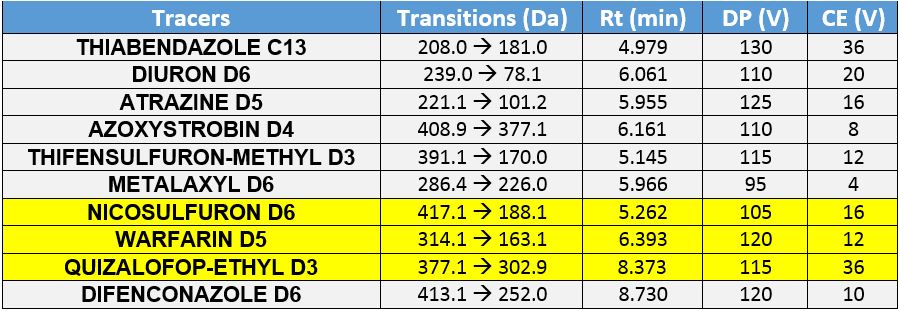|
Introduction
Nowadays keeping water clean is a real challenge. That’s why to analyze chemical contaminants in water is a priority to ensure human health. So considering the risks, their presence in water is the object of regular controls. Pesticides are characterized by poor volatility, thermal stability and intermediate polarity that enable them to be analyzed by liquid chromatography coupled with tandem mass spectrometry (LC-MS/MS).
In order to verify the good progress of the whole procedure (preparation, injection and ionisation), tracers are added to each sample. At the moment, there are 3 tracers representing 3 groups of pesticides classified by chemical family. The aim of this project was to add new tracers to the routine method, representing a range of given retention times instead of a chemical family.
Experimental conditions
The first step was to determine the new tracer transitions and to optimize the mass parameters by Multiple Reaction Monitoring. A solution of each individual tracer was introduced directly into the source electrospray ESI of the mass spectrometer. The two most intense MRM transitions were selected. Moreover the declustering potential (DP) and the collision energy (CE) were determined for each new tracer.
At the same time, the retention time was determined with the routine analytical conditions : a column Zorbax Eclipse plus C18 (150mm*2,1mm*3,5µm), a H2O/MeOH mobile phase acidified by formica acid and containing ammonium formate, with the flow rate of 0.4 mL/min.
The last step was to verify the possible presence of interference between tracers and pesticides.
Results
A selection of 10 new tracers to test were chosen because of their availability in the laboratory for other routine methods.
In LC-MS/MS, a molecule is identified by its retention time and its MRM transitions. So each of the new tracers were analyzed and all optimized parameters are presented in table n°1.
Most of new tracers were eluted at about 5/6 min, just two at about 8 min. In addition, three tracers were detected as interferents because of their same retention time and transitions with pesticides.
Conclusion
In conclusion, tracers showing interference with pesticides were removed from the list.
Because the tracer Difenconazole D6 was the last one eluted at about 8 min, it will probably be chosen for the range 7-12 min retention time. The other range 0-7 min will be representated by another new tracer.
This will be determined by the next steps of validation.
|
|

Table n°1 : Presentation of the first transition, retention time (Rt) and mass parameters for each new tracer. Those interfering with pesticides are also highlighted in yellow.
|



